The Tasks
Click Here for a complete listing of ALL the competition rules and task descriptions.
PILOT DECLARED GOAL (PDG)
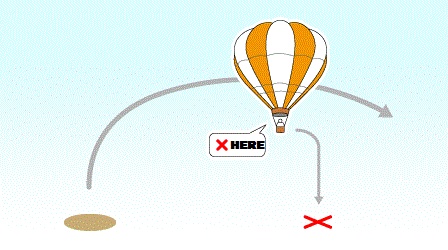 It is the game that pilots declares his or her goal before their takeoff, and they drop the marker off approaching. They need to read the direction and speed of wind with map accurately. It is a high degree of difficulty compared to other tasks.
It is the game that pilots declares his or her goal before their takeoff, and they drop the marker off approaching. They need to read the direction and speed of wind with map accurately. It is a high degree of difficulty compared to other tasks.
- Competitors will attempt to achieve a mark or valid track point close to a goal selected and declared by him.
- Task Data: a) Method of declaration (also see Section II.12 and 12.3) b) Number of goals permitted c) Goals available for declaration d) Minimum and maximum distances of goal(s) from CLP or ILP as per TDS e) Minimum distance of goal(s) from any subsequent goals or targets, if applicable
- The result is the distance from the mark or closest valid track point to the nearest valid declared goal. Smallest result is best.
JUDGE DECLARED GOAL (JDG)
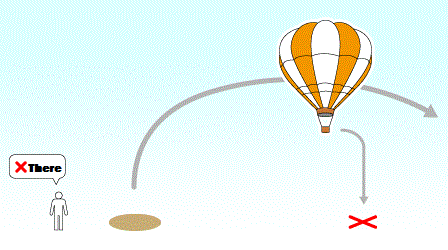 Balloons attempt to fly to a valid mark or track point that the Event Director ordered. Launch point is usually 1 to 4 km away from the goal. The pilots drop the marker toward the center of a target or fly a track closest to the goal. The winner who gets nearest gets 1000 points.
Balloons attempt to fly to a valid mark or track point that the Event Director ordered. Launch point is usually 1 to 4 km away from the goal. The pilots drop the marker toward the center of a target or fly a track closest to the goal. The winner who gets nearest gets 1000 points.
- Competitors will attempt to achieve a mark or valid track point close to a set goal.
- Task Data: a) Position of set goal/target
- Result is distance from the mark or closest valid track point to the target, if displayed, or goal. Smallest result is best.
HESITATION WALTZ (HWZ)
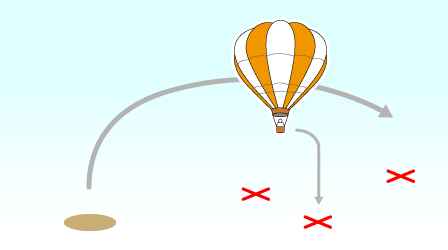 Balloons fly to the goal which the Event Director ordered. It is usually 4 to 6 km away from the goal. The pilots drop the marker toward the center of the target and the winner who made the nearest gets 1000 points. This is very similar to Judge Declared Goal / JDG. The difference between HWZ and JDG is that there are plural targets in HWZ and pilots need to decide one target from them.
Balloons fly to the goal which the Event Director ordered. It is usually 4 to 6 km away from the goal. The pilots drop the marker toward the center of the target and the winner who made the nearest gets 1000 points. This is very similar to Judge Declared Goal / JDG. The difference between HWZ and JDG is that there are plural targets in HWZ and pilots need to decide one target from them.
- Competitors will attempt to achieve a mark or valid track point close to one of several set goals.
- Task Data: a) Position of various set goals/targets
- The result is distance from the mark or closest valid track point to the nearest target, if displayed, or goal. Smallest result is best.
FLY IN (FIN)
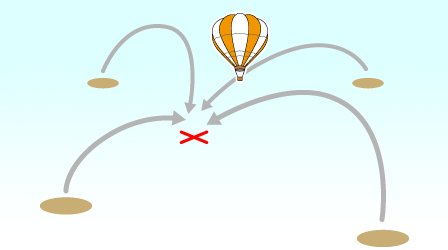 Event Directors decide one goal. It is usually set in the launch area of Kase Riverbed. Balloons takeoff from some distances away (for example, 5km away) for the target. They can take off and fly from any directions.
Event Directors decide one goal. It is usually set in the launch area of Kase Riverbed. Balloons takeoff from some distances away (for example, 5km away) for the target. They can take off and fly from any directions.
- Competitors find their own launch areas and attempt to achieve a mark or valid track point close to a set goal or target.
- Task Data: a) Position of set of goal/target
- The result is the distance from the mark or closest valid track point to the target, if displayed, or goal. Smallest result is best.
FLY ON (FON)
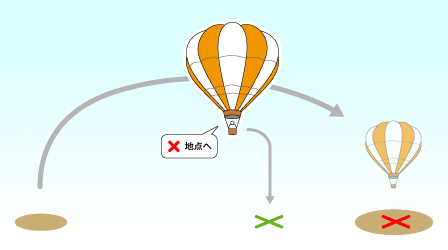 This game is always held with the combination of other tasks. At first, pilots drop markers of another task. At this time, pilots need to write where to drop the next marker. This task is similar to Pilot Declared Goal (PDG).
This game is always held with the combination of other tasks. At first, pilots drop markers of another task. At this time, pilots need to write where to drop the next marker. This task is similar to Pilot Declared Goal (PDG).
- Competitors will attempt to achieve a mark or valid track point close to a goal selected and declared by them before take-off or during flight.
- Task Data: a) Method of declaration (also see Section II.12 and 12.3 b) Number of goals permitted c) Goals available for declaration d) Declaration point requirement e) Minimum and maximum distance between declaration point and declared goal(s) f) Minimum and maximum distances of declared goal(s) from any other targets noted on TDS.
- The result is the distance from the mark or closest valid track point to the nearest valid declared goal. Smallest result is best.
- Rules governing the declaration methods are in Section II.12 and shall be detailed on the TDS.
- A competitor shall identify his goal by map coordinates. For goal declaration of pre-defined goals, the goal number may be used. 12. 3.2 A goal declaration violating the restrictions of Section II will be considered invalid and the competitor will not achieve a result. In case the competitor is allowed to declare more than one goal in a task and one or more goals are invalid, the competitor will be scored to the nearest valid goal if any. 12. 3.3 In tasks where a competitor is required to declare his goal(s) or other declarations according to the TDS, he shall do so in writing and his declaration shall be deposited before declaration time at the place of the declaration box specified in the briefing data, clearly identified with his name and/or competition number. If more goals or declarations are made than permitted, the competitor will be scored to the least advantageous valid goal. A competitor who wishes to revise his declaration may deposit a further declaration, within the declaration time, if it is clearly marked to distinguish it from any previous declaration(s). The timekeeper/official will close the declaration box precisely at the declaration time, and will accept late goal declarations, writing the time in minutes and seconds on each. 12. 3.4 Penalty for late declarations that must be made a specified time before take-off is 100 task points per minute or part of a minute late. If the competitor fails to declare before take-off, he will not achieve a result. 12. 3.5 If a declaration may be made in flight – before a defined time, point or boundary – and the competitor fails to do so, he will not achieve a result. Goals not meeting distance limitations will be scored according to the rule on distance infringements.
HARE AND HOUNDS (HNH)
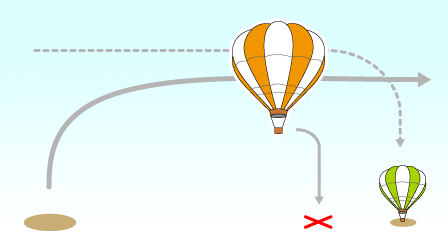 The hot-air-balloon, playing the role of the hare (rabbit), takeoffs at first, and the competition balloons takeoff 15 to 30 min. later. They chase the hare balloon, which is flying away for about one hour and sets the target it lands. They need to guess and find its target and drop the marker toward it.
The hot-air-balloon, playing the role of the hare (rabbit), takeoffs at first, and the competition balloons takeoff 15 to 30 min. later. They chase the hare balloon, which is flying away for about one hour and sets the target it lands. They need to guess and find its target and drop the marker toward it.
- Competitors will follow a hare balloon and attempt to achieve a mark or valid track point close to a target displayed by the hare no more than two meters upwind of the basket after landing.
- Task Data: a) Description of hare balloon b) Intended flight duration of hare balloon
- The result is the distance from the mark or closest valid track point to the target. Smallest result is best.
- Variation from intended flight duration of the hare shall not be grounds for complaint.
- The hare may deflate after landing and may be removed from the field.
- The hare balloon may display a banner hanging below his basket. No competitor shall display any banner hanging below the basket during this task.
WATERSHIP DOWN (WSD)
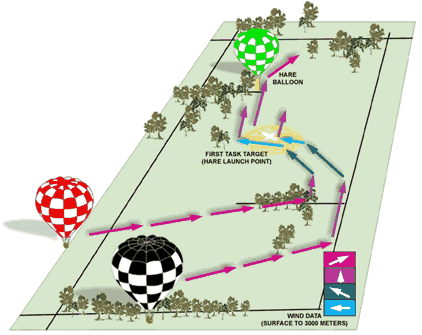 Competitors will fly to the launch point of a hare balloon, follow the hare, and attempt to achieve a mark or valid
track point close to a target displayed by the hare no more than two meters upwind of the basket after landing.
Competitors will fly to the launch point of a hare balloon, follow the hare, and attempt to achieve a mark or valid
track point close to a target displayed by the hare no more than two meters upwind of the basket after landing.- Task Data: a) Description of hare balloon b) Location of the launch point of the hare balloon c) Set take-off time of the hare balloon d) Intended flight duration of the hare balloon e) Minimum and maximum distances of ILP from hare launch point, if applicable
- The result is the distance from the mark or closest valid track point to the target. Smallest result is best.
- If the hare balloon does not take off within five minutes after the set time then this task is considered cancelled.
- Variation from the intended flight duration of the hare shall not be grounds for complaint.
- The hare may deflate after landing and may be removed from the field.
- The hare may display a banner hanging below his basket. No competitor shall display any banner hanging below the basket during this task.
GORDON BENNETT MEMORIAL (GBM)
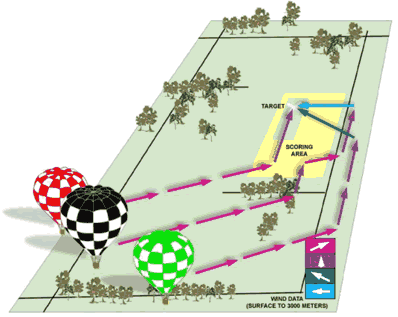 Competitors will attempt to achieve a mark or closest valid track point within a scoring area(s) close to a set goal.
Competitors will attempt to achieve a mark or closest valid track point within a scoring area(s) close to a set goal.- Task Data: a) Position of goal/target b) Description of scoring area(s)
- The result is the distance from the mark or closest valid track point to the target, if displayed, or goal. Smallest result is best.
CALCULATED RATE OF APPROACH TASK (CRT)
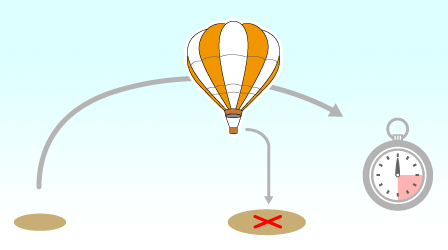 This task is similar to Fly In (FIN), and the target is set in the event area by the Event Director. Pilots fly from some distances away (for example, 5km away) toward the target and drop the marker. However the time and the area to drop the marker are limited then. Pilots have to fly calculating the time to reach the target.
This task is similar to Fly In (FIN), and the target is set in the event area by the Event Director. Pilots fly from some distances away (for example, 5km away) toward the target and drop the marker. However the time and the area to drop the marker are limited then. Pilots have to fly calculating the time to reach the target.
- Competitors will attempt to achieve a mark within a valid scoring area close to a set goal. The scoring area(s) will have unique times of validity.
- Task Data: a) Position of goal/target b) Description of scoring area(s) and their validity times
- The result is the distance from the mark to the target. Smallest result is best.
- A competitor who does not achieve a mark (marker on the ground) inside a scoring area during the time of validity
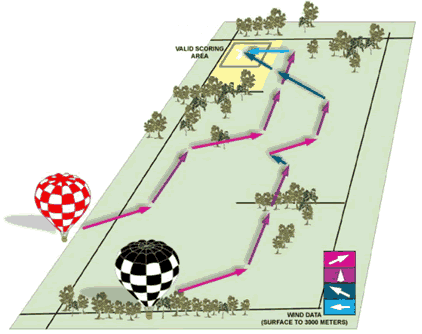
- will not achieve a result.
RACE TO AN AREA (RTA)
 Competitors will attempt to achieve a mark or valid track point, as specified in the Task Data in the shortest time
within a scoring area(s) or airspace(s).
Competitors will attempt to achieve a mark or valid track point, as specified in the Task Data in the shortest time
within a scoring area(s) or airspace(s).- Task Data: a) Arrangements for timing b) Description of Scoring Area(s)
- The result is the elapsed time from the initial timing point to the mark or first valid track point. Shortest time is best.
- Timing ends at the moment the marker is released, falling, or on the ground as seen by the officials, the electronic mark is dropped (Flytec loggers only) or at the moment of the first valid track point in the scoring area if track points only were set.
ELBOW (ELB)
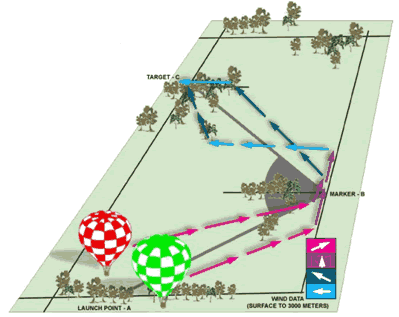 Competitors will attempt to achieve the greatest change of direction in flight.
Competitors will attempt to achieve the greatest change of direction in flight.- Task Data: (If no markers are used) a) Description of point “A” b) Description of point “B” c) Description of point “C”
- The result is 180 degrees minus the angle ABC. Greatest result is best.
MINIMUM DISTANCE (MDT)
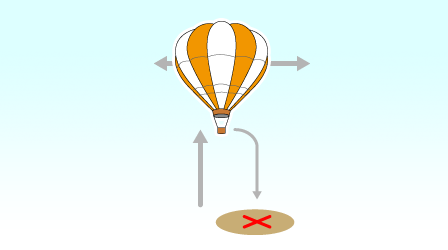 After pilots fly fixed interval (about 30 or 45 min.), they drop their marker. The distance between the point its marker has dropped and the target set in the takeoff area should be shorter. The winner who made the shortest distance gets 1000 points. The key point is that how they keep from not to moving in the sky or how they come back to the takeoff area.
After pilots fly fixed interval (about 30 or 45 min.), they drop their marker. The distance between the point its marker has dropped and the target set in the takeoff area should be shorter. The winner who made the shortest distance gets 1000 points. The key point is that how they keep from not to moving in the sky or how they come back to the takeoff area.
- Competitors will attempt to achieve a mark or valid track point close to the common reference point, after flying a minimum set time or distance.
- Task Data: a) Arrangements of timing b) Minimum set time or distance c) Reference point
- The result is the distance from the mark or closest valid track point to the common reference point. Smallest 2D result is best.
- The scoring position is the mark or best track point after the minimum time or distance has elapsed. Otherwise the scoring position will be the landing position, provided that the balloon has been seen by an official to be still airborne after the minimum time
LAND RUN (LRN)
- Competitors will attempt to achieve the greatest area of a triangle ABC.
- Task Data: a) Location of point "A" b) Method of determining point "B" c) Method of determining point "C" d) Description of scoring area(s)
- The result is the area of triangle ABC. Greatest result is best.
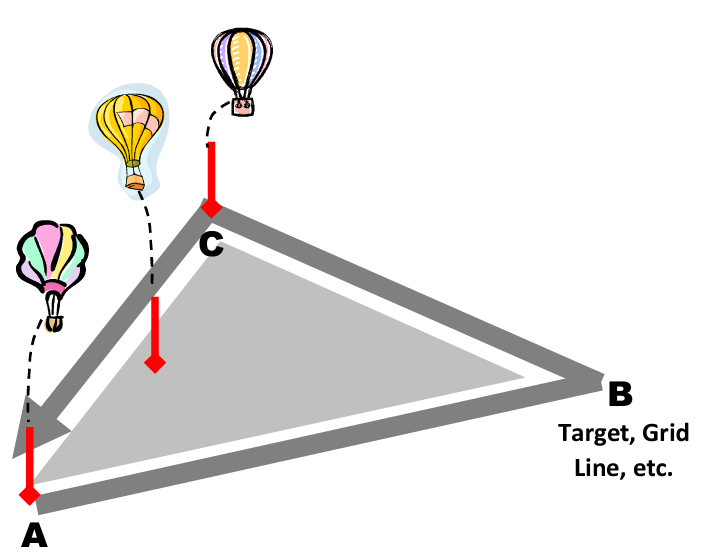
SHORTEST FLIGHT (SFL)
SHORTEST FLIGHT (SFL) Competitors will attempt to achieve a mark or valid track point within a set scoring area(s) close to the common reference point. Task Data- Description of scoring area(s)
- Reference point
MINIMUM DISTANCE DOUBLE DROP (MDD)
Competitors will attempt to achieve two marks or valid track points close together in different scoring areas.- Task Data: a) Description of the scoring areas
- The result is the distance between the marks or track points. Smallest 2D result is best.
- Competitors will not achieve a result, unless they have valid track points or marks in different scoring areas as per the Task Data Sheet.
MAXIMUM DISTANCE TIME (XDT)
Competitors will attempt to achieve a mark or valid track point far away from the common reference point, within a maximum set time.- Task Data: a) Maximum set time b) Arrangements for timing c) Reference point
- The result is the distance from the mark or furthest valid track point to the reference point. Greatest 2D result is best.
MAXIMUM DISTANCE (XDI)
Competitors will attempt to achieve a mark or valid track point within a set scoring area(s) far away from the common reference point- Task Data: a) Description of scoring area(s) b) Reference point
- The result is the distance from the mark or valid track point to the common reference point. Greatest 2D distance is best.
MAXIMUM DISTANCE DOUBLE DROP (XDD)
Competitors will attempt to achieve two marks or valid track points far apart in the scoring area(s).- Task Data: a) Description of Scoring Area(s)
- The result is the distance between the marks or farthest valid track points. Greatest 2D result is best.
ANGLE TASK (ANG)
Competitors will attempt to achieve the greatest change of direction from a set direction. The change of direction is the angle between the set direction and line “A-B”.- Task Data: a) Description of points “A” and “B” b) Set direction (degrees) c) Minimum and maximum distances from “A” to “B”
- The result is the angle between the set direction and the line “A-B”. Greatest result is best.
3-D SHAPE TASK (3DT)
15.20 Competitors will attempt to achieve the greatest distance within a set airspace.- Task Data: a) Description of set airspace(s)
- The result is the accumulated horizontal distance between valid track points in the set airspace(s). Greatest result is best.
LEAST TIME TASK (LTT)
15.21 Competitors will attempt to fly across a given scoring area in the least amount of time.- Task Data: Boundaries of scoring area
- Result is elapsed time to cross the scoring area, measured from initial point of entry to exit point of scoring area. Least time is best.
MOST TIME TASK (MTT)
15.22 Competitors will attempt to fly across a given scoring area in the most amount of time (slowest speed).- Task Data: Boundaries of scoring area
- Result is elapsed time to cross the scoring area, measured from initial point of entry to exit point of scoring area. Greatest amount of time is best.
